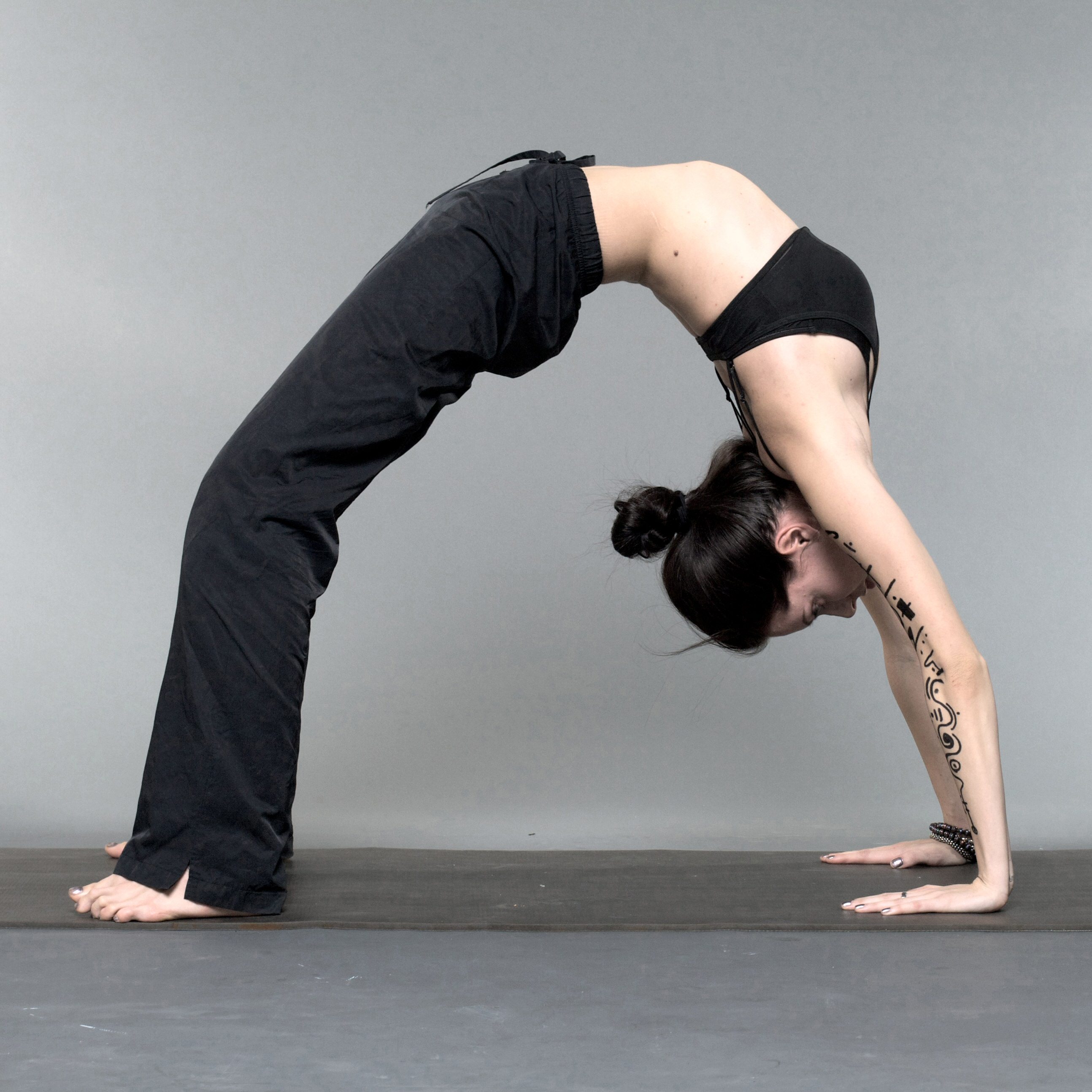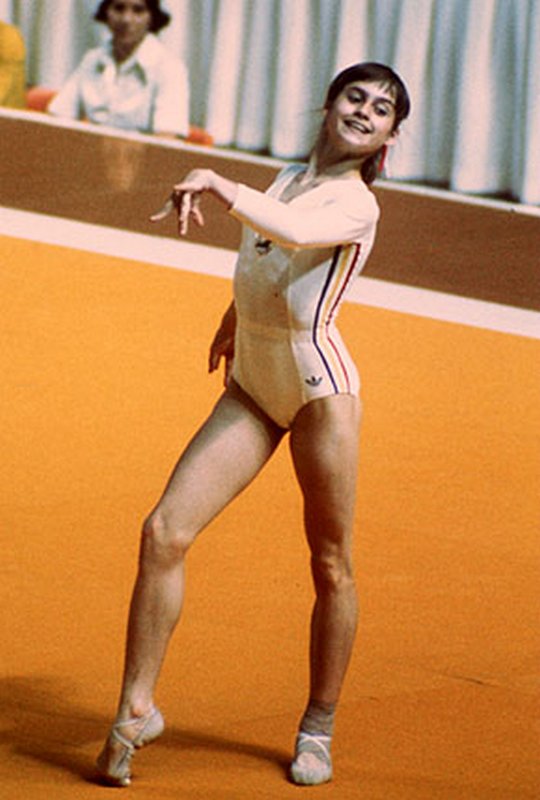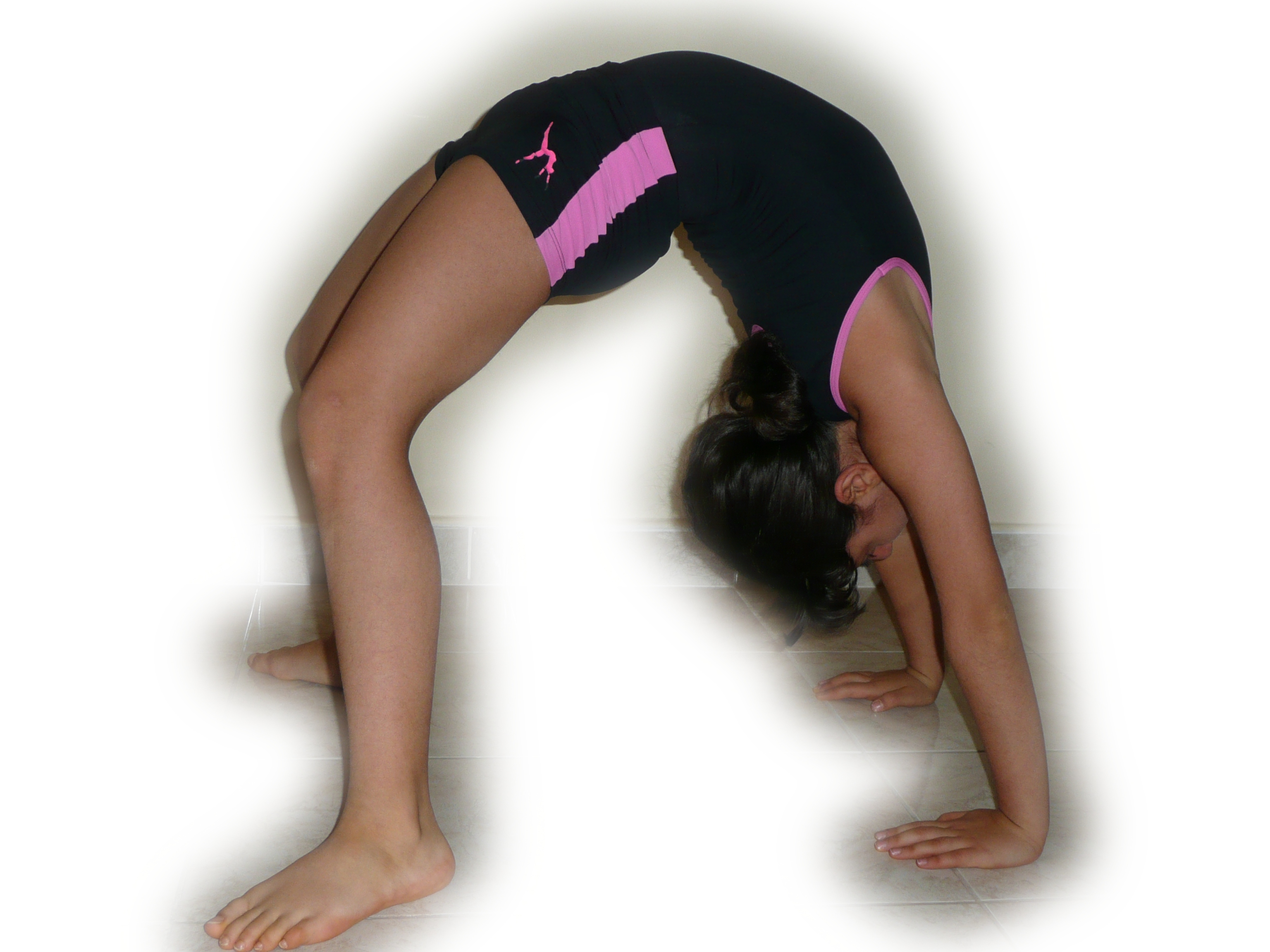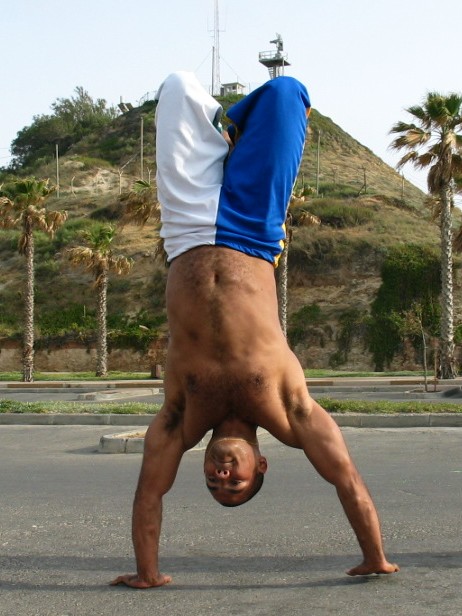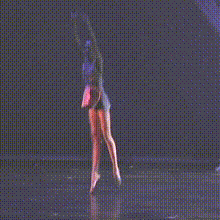|
Back Walkover
A back walkover is an acrobatic maneuver in which a person transitions from a standing position to a back bridge and then back to a standing position again, undergoing a complete revolution of the body in the process. Back walkovers are commonly performed in a variety of athletic activities, including acro dance, cheerleading, and rhythmic gymnastics. In artistic gymnastics, back walkovers are performed in floor exercises and on the balance beam. Technique The back walkover performer begins in a standing position. The back is increasingly arched and abdominal muscles are stretched until the hands touch the floor and all hands and feet are flat on the floor, thus forming a gymnastic back bridge. While in the bridge position, one leg (the ''leading'' leg) is rapidly raised from the floor so as to impart momentum to the lower body. This momentum lifts the trailing leg from the floor so that only the hands are left touching the floor. Both hands remain on the floor while the body revolv ... [...More Info...] [...Related Items...] OR: [Wikipedia] [Google] [Baidu] |
Acrobatic
Acrobatics () is the performance of human feats of balance (ability), balance, agility, and motor coordination. Acrobatic skills are used in performing arts, sports, sporting events, and martial arts. Extensive use of acrobatic skills are most often performed in acro dance, circus, and gymnastics, and to a lesser extent in other athletic activities including ballet, slacklining and Diving (sport), diving. Although acrobatics is most commonly associated with human body performance, the term is used to describe other types of performance, such as aerobatics. History Acrobatic traditions are found in many cultures, and there is evidence that the earliest such traditions occurred thousands of years ago. For example, Minoan civilization, Minoan art from c. 2000 BC contains depictions of bull-leaping, acrobatic feats on the backs of bulls. Ancient Greeks practiced acrobatics, and the noble court displays of the European Middle Ages would often include acrobatic performances that ... [...More Info...] [...Related Items...] OR: [Wikipedia] [Google] [Baidu] |
Back Bridge
Chakrasana ( sa, चक्रासन, lit=Wheel Pose, translit=Cakrāsana) or Urdhva Dhanurasana ( sa, ऊर्ध्वधनुरासन, lit=Upward-Facing Bow Pose, translit=Ūrdhvadhanurāsana) is a backbending asana in yoga as exercise. The one-legged variant is often chosen by yoga practitioners who wish to advertise themselves. Etymology and origins The name Chakrasana comes from the Sanskrit words चक्र ''chakra'', "wheel", and आसन ''āsana'', "posture" or "seat". The name Urdhva Dhanurasana comes from the Sanskrit ''urdhva'' ऊर्ध्व, upwards, and ''dhanura'' धनु, a bow (for shooting arrows). The pose is illustrated in the 19th century ''Sritattvanidhi'' as ''Paryaṇkāsana'', Couch Pose. Description In the general form of the asana, the practitioner has hands and feet on the floor, and the abdomen arches up toward the sky. It may be entered from a supine position or through a less rigorous supine backbend, such as Setu Bandha Sarva ... [...More Info...] [...Related Items...] OR: [Wikipedia] [Google] [Baidu] |
Acro Dance
Acro dance is a style of dance that combines classical dance technique with precision acrobatic elements. It is defined by its athletic character, its unique choreography, which seamlessly blends dance and acrobatics, and its use of acrobatics in a dance context. It is a popular dance style in amateur competitive dance as well as in professional dance theater and in contemporary circus productions such as those by Cirque du Soleil. This is in contrast to acrobatic, artistic and rhythmic gymnastics, which are sports that employ dance elements in a gymnastics context under the auspices of a governing gymnastics organization (such as FIG) and subject to a Code of Points. Acro dance is known by various other names including ''acrobatic dance'' and ''gymnastic dance'', though it is most commonly referred to simply as ''acro'' by dancers and dance professionals. Acro is an especially challenging dance style for dancers as it requires them to be trained in both dance and acrobatic sk ... [...More Info...] [...Related Items...] OR: [Wikipedia] [Google] [Baidu] |
Cheerleading
Cheerleading is an activity in which the participants (called cheerleaders) cheer for their team as a form of encouragement. It can range from chanting slogans to intense physical activity. It can be performed to motivate sports teams, to entertain the audience, or for competition. Cheerleading routines typically range anywhere from one to three minutes, and contain components of tumbling, dance, jumps, cheers, and stunting. Modern cheerleading is very closely associated with American football and basketball. Sports such as association football (soccer), ice hockey, volleyball, baseball, and wrestling will sometimes sponsor cheerleading squads. The ICC Twenty20 Cricket World Cup in South Africa in 2007 was the first international cricket event to have cheerleaders. The Florida Marlins were the first Major League Baseball team to have a cheerleading team. Cheerleading originated as an all-male activity in the United States, and remains predominantly in America, with an e ... [...More Info...] [...Related Items...] OR: [Wikipedia] [Google] [Baidu] |
Rhythmic Gymnastics
Rhythmic gymnastics is a sport in which gymnasts perform on a floor with an apparatus: hoop, ball, clubs, ribbon. The sport combines elements of gymnastics, dance and calisthenics; gymnasts must be strong, flexible, agile, dexterous and coordinated. Rhythmic gymnastics is governed by the International Gymnastics Federation (FIG), which first recognized it as a sport in 1963. It became an Olympic sport in 1984, with an individual all-around event. The group all-around competition was added to the Olympics in 1996. At the international level, rhythmic gymnastics is a women-only sport. The most prestigious competitions, besides the Olympic Games, are the World Championships, World Games, European Championships, European Games, the World Cup Series and the Grand Prix Series. Gymnasts are judged on their artistry, execution of skills, and difficulty of skills, for which they gain points. They perform leaps, balances, and rotations along with handling the apparatus. History Rhythm ... [...More Info...] [...Related Items...] OR: [Wikipedia] [Google] [Baidu] |
Artistic Gymnastics
Artistic gymnastics is a discipline of gymnastics in which athletes perform short routines on different apparatuses. The sport is governed by the Fédération Internationale de Gymnastique (FIG), which designs the Code of Points and regulates all aspects of elite international competition. Within individual countries, gymnastics is regulated by national federations like British Gymnastics and USA Gymnastics. Artistic gymnastics is a popular spectator sport at many competitions, including the Summer Olympic Games. History The gymnastic system was mentioned in writings by ancient authors, including Homer, Aristotle, and Plato. It included many disciplines that later became independent sports, such as swimming, racing, wrestling, boxing, and horse riding. It was also used for military training. In its present form, gymnastics evolved in Bohemia and what is now known as Germany at the beginning of the 19th century. The term "artistic gymnastics" was introduced to distinguish fr ... [...More Info...] [...Related Items...] OR: [Wikipedia] [Google] [Baidu] |
Floor Exercise
In gymnastics, the floor is a specially prepared exercise surface, which is considered an apparatus. It is used by both male and female gymnasts. The gymnastics event performed on the floor is called floor exercise. The English abbreviation for the event in gymnastics scoring is FX. A spring floor is used in all of gymnastics to provide more bounce, and also help prevent potential injuries to lower extremity joints of gymnasts due to the nature of the apparatus, which includes the repeated pounding required to train it. Cheerleading also uses spring floors for practice. The sprung floor used for indoor athletics, however, is designed to reduce bounce. The apparatus The apparatus originated as a 'free exercise' for men, very similar to the floor exercise of today. Most competitive gymnastics floors are spring floors. They contain springs and/or a rubber foam and plywood combination which make the floor bouncy, soften the impact of landings, and enable the gymnast to gain heigh ... [...More Info...] [...Related Items...] OR: [Wikipedia] [Google] [Baidu] |
Balance Beam
The balance beam is a rectangular artistic gymnastics apparatus and an event performed using the apparatus. Both the apparatus and the event are sometimes simply referred to as "beam". The English abbreviation for the event in gymnastics scoring is BB. The beam is a small, thin beam which is typically raised from the floor on a leg or stand at both ends. The balance beam is only performed competitively by female gymnasts. Beams are usually covered with leather-like material and are only four inches wide. Balance beams used in international gymnastics competitions must conform to the guidelines and specifications set forth by the International Gymnastics Federation ''Apparatus Norms'' brochure. Several companies manufacture and sell beams, including AAI (USA), Janssen Fritsen (Europe) and Acromat (Australia). Most gymnastics schools purchase and use balance beams that meet the FIG's standards, but some may also use beams with carpeted surfaces for practice situations. While learning ... [...More Info...] [...Related Items...] OR: [Wikipedia] [Google] [Baidu] |
Bridge (exercise)
The bridge (also called gymnastic bridge) is an exercise. Many variations of this exercise are employed throughout the world, most commonly the balancing of the body on the hands and the feet. It is intended to improve lower back and gluteus strength. Examples of bridging in sportive or self-defense applications are seen in Kung Fu, Judo, Brazilian jiu jitsu, Capoeira, mixed martial arts, and wrestling. In yoga, this particular pose is called Chakrasana, Urdhva Dhanurasana, or Wheel, while the Westernized nickname "Bridge pose" refers to a less rigorous supine backbend called Setu Bandha Sarvangasana, in which the body is fairly straight from knees to shoulders, and most of the bend is in the knees. Variations The bridging exercise is not a singular movement, but includes a wide range of variations and progressions. There is no single agreed upon "standard" variation of the bridge like with other common bodyweight exercises. Bridge hold The bridge hold is a static variat ... [...More Info...] [...Related Items...] OR: [Wikipedia] [Google] [Baidu] |
Handstand
__NOTOC__ A handstand is the act of supporting the body in a stable, inverted vertical position by balancing on the hands. In a basic handstand, the body is held straight with arms and legs fully extended, with hands spaced approximately shoulder-width apart and the legs together. There are many variations of handstands, all of which require the performer to possess adequate balance and upper body strength. Kinematics Handstands use the wrist flexor muscles as well as the anterior deltoid, pectoralis major, latissimus dorsi, biceps brachii, and trapezius descendens. It is considered demanding in terms of both the muscle and joint requirement. According to a 2017 study most handbalancers use wrist movement to maintain balance in a handstand. Another study found that handbalancers who were also expert gymnasts had better coordination than those at an intermediate level of gymnastics. More advanced practitioners also altered their center of pressure less to change the center of mas ... [...More Info...] [...Related Items...] OR: [Wikipedia] [Google] [Baidu] |
Front Walkover
A front walkover is an acrobatic movement sequence. It begins with the performer standing up straight with arms raised and positioned near to the ears. The performer then lunges forward and quickly raises one leg, with the other leg following as if transitioning to a handstand. The legs are held straight in a split as they travel overhead. The back is then arched until the leading foot touches the floor, such that the performer is briefly in a back bridge position. After the trailing foot reaches the floor, the performer returns to a standing position. In gymnastics, a front walkover typically ends with one foot extended in front and arms raised. Front walkovers are performed in various activities, including acro dance, circus, and gymnastics. See also *Back walkover *Front aerial *Front limber A front limber is a gymnastics skill where the gymnast performs a handstand, carries the momentum forward, landing in a bridge, and then pulls their upper body upwards, ending in a standing ... [...More Info...] [...Related Items...] OR: [Wikipedia] [Google] [Baidu] |

